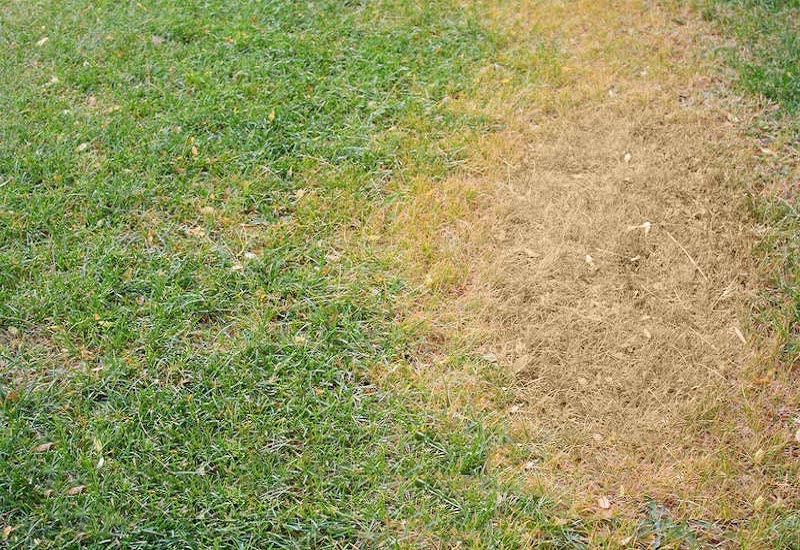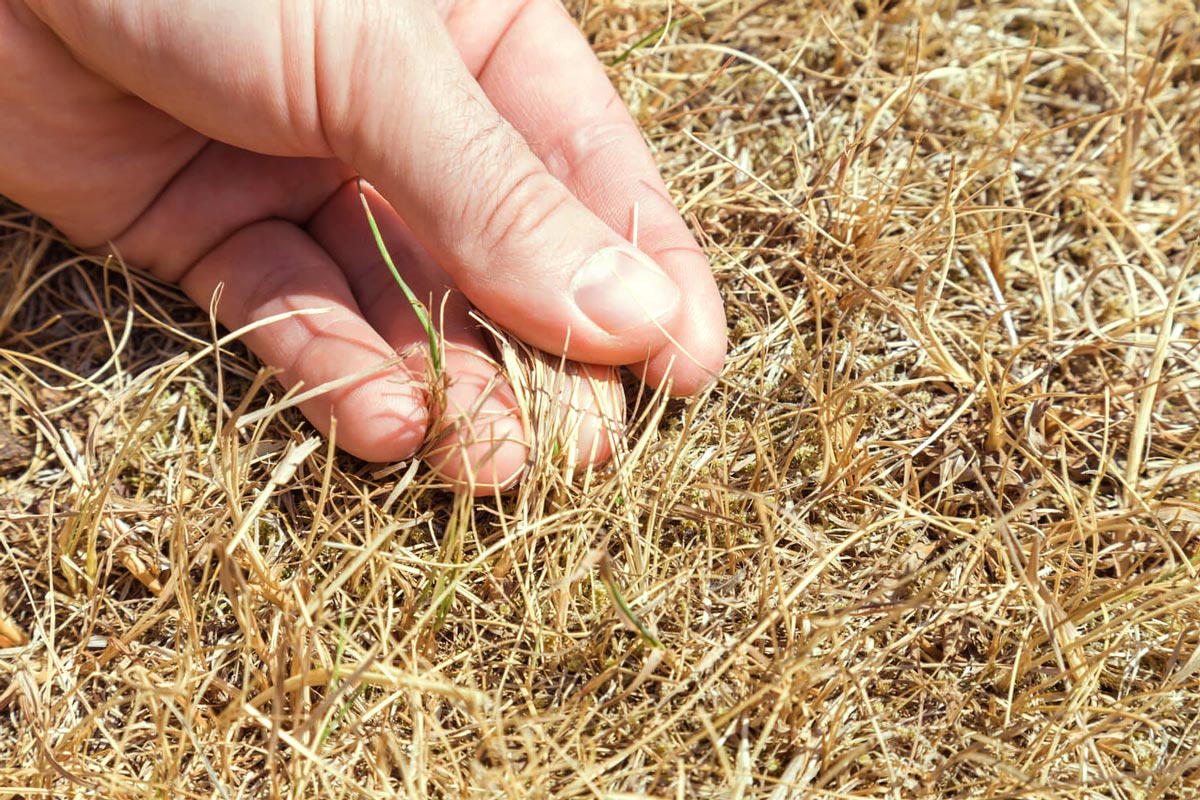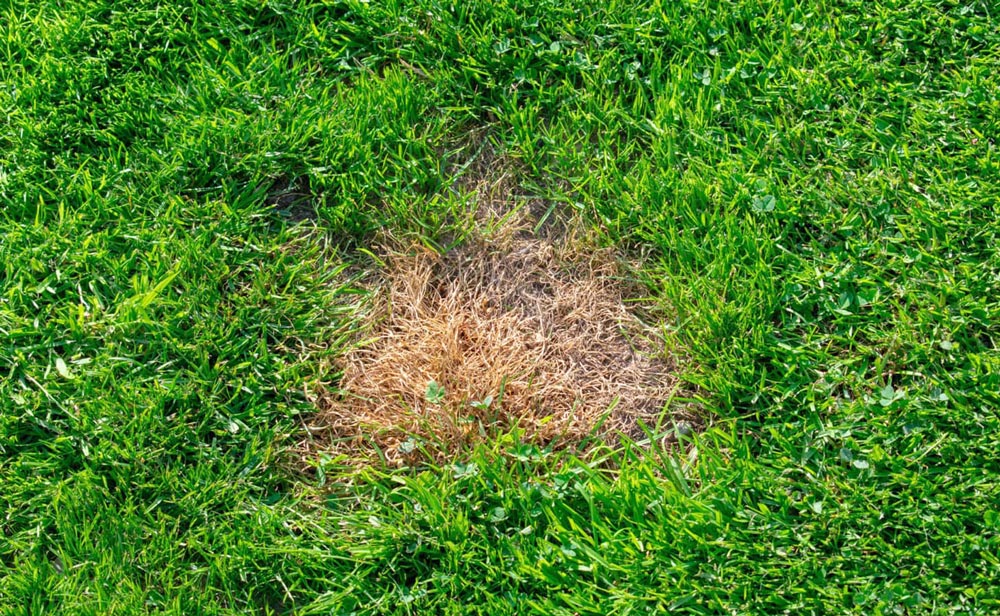Imagine walking out to your once-lush green lawn only to find it riddled with unsightly brown patches. Panic sets in. Is it too late to save your lawn? Don’t worry!
First, you need to identify the cause of burnt grass. Use remedies such as deep watering & sharp mowing to revive burnt grass and follow preventive tips for long-term success.
You can also take proactive steps like proper fertilization, adjusting watering & mowing practices, and using damage prevention products for a healthy lawn
What we cover
ToggleCauses of burnt grass

Before we can fix the problem, we need to identify the root cause. Burnt grass can be a result of various factors, such as overfertilization, heat stress, dog urine, and herbicide misuse.
By understanding the cause, we can take appropriate measures to address the issue and prevent future occurrences.
Overfertilization
Overfertilization is often the result of excessive amounts of fast-release fertilizers, leading to excess nitrogen or other mineral salts in the soil. This can cause burnt grass, weakened root systems, and even fungal diseases.
So, how can we prevent overfertilization? It’s important to use slow-release fertilizers and apply only the recommended amount. Doing so can ensure a healthy, green lawn without the risk of fertilizer burn.
Heat stress
Heat stress occurs when grass enters a protective mechanism known as “heat dormancy” during hot summer months.
The grass enters a resting phase, drawing reserve substances from the blades down to the roots for protection in preparation for cooler temperatures and more rain.
While this natural response helps grass survive, it can appear yellow or brown.
To manage heat stress, it’s important to adjust your lawn care practices, such as watering and mowing, during hot periods.
Dog urine
Dog urine contains high levels of nitrogen, which can cause grass to turn brown and die when applied in excess.
While small amounts of dog urine can actually benefit your lawn, concentrated amounts can lead to burnt grass and unsightly brown patches.
To treat burnt grass caused by dog urine, you can use lawn damage prevention products and keep your dog away from the area while the grass is growing.
Additionally, ensure your dog is well-hydrated and consider incorporating wet food into their diet to help dilute the concentration of nitrogen in their urine.
Herbicide misuse
Herbicide misuse can cause significant damage to your lawn if not used correctly. Potential outcomes of herbicide misuse can range from environmental damage to human health risks, and even legal penalties.
To avoid herbicide-related burns, it’s crucial to follow the instructions on the product label, use the correct product for the job, and apply the herbicide in the right amount and in the right place.
By adhering to these guidelines, you can ensure the safe and effective use of herbicides for a healthy lawn.
Assessing the damage: checking grass roots

Now that we’ve identified the possible causes of burnt grass, it’s time to assess the damage. To do so, check the grassroots, including deep roots, to see if you can save the burnt grass.
The roots are indicative of the grass’s health. If they are moist, flexible, and overall look healthy, there is a possibility to salvage them.
In order to promote recovery, you’ll need to water the affected area excessively to help flush out harmful minerals and stimulate new growth.
Watering techniques for burnt grass recovery
Proper watering is key to reviving burnt grass. Watering with an inch of water daily for a week will help flush out minerals and stimulate new growth for a successful recovery.
Be sure to water your grass in the morning when the atmosphere is still cool for optimal results.
This will provide your lawn with the essential nutrients it needs to repair itself and prevent further damage caused by heat stress or overfertilization.
Repairing fertilizer burn
To repair fertilizer burn, rake and till the affected areas to create an ideal environment for new grass seeds to take root and flourish.
Tilling or aerating the soil can help loosen any compacted soil, making it easier for the new grass to grow.
Use a home soil test from a lawn and garden store to ensure your soil has the right nutrient and pH levels.
Once the soil is prepared, lay new soil or reseed the affected area and water it daily for at least a week to ensure a lush and vibrant lawn.
Treating burnt grass from dog urine

To treat burnt grass caused by dog urine, remove the dead grass from the area and repair the spot with a patch product, apply limestone and re-seed, or water the area immediately after a dog has urinated to dilute the concentration of nitrogen.
Prevent future damage by using dog urine lawn damage prevention products and keeping your dog away from the area while the grass is growing.
Additionally, ensure your pup has access to plenty of fresh, clean water and incorporate wet food into their diet to help keep them hydrated.
Managing heat-stressed lawns
To manage heat-stressed lawns, water the lawn deeply in the morning to give it a cooling boost. Mow in mid-morning to avoid adding additional stress to your grass.
Having a longer lawn in summer can also help conserve water, benefiting your lawn in the long run.
Finally, ensure your mower has sharp blades for a clean, crisp cut. By taking these proactive steps, you can help your grass stay cool and healthy during periods of extreme heat.
Addressing herbicide-related burn
When dealing with herbicide-related burns, the best course of action is to plant new grass seeds. This will give your lawn a fresh start and help it recover from the damage caused by the herbicide.
To ensure great coverage and growth when reseeding, follow the directions for the type of grass seed you have for optimal results.
Remember to water the seeds daily to ensure a healthy and thriving lawn after the herbicide damage has been addressed.
Lawn care tips for preventing burnt grass
Preventing burnt grass begins with proper lawn care. Some essential tips for a healthy lawn include:
- Watering properly
- Mowing high
- Watering after fertilizing
- Adjusting your dog’s diet
- Using the correct fertilizer spreader
- Opting for natural fertilizers
Additionally, avoid watering too shallowly, as this can harm and even kill the grass. By consistently practicing these lawn care tips, you can maintain a vibrant, green lawn without the risk of burnt grass.
Remedies for reviving burnt grass
To revive burnt grass, you can remove the burnt grass, add new soil, water frequently, cover with straws, use sugar, re-sod or reseed, water daily, cut new grass high, and leave cuttings to nourish the soil.
Adding new soil is particularly effective for severely heat-burnt grass.
Using sugar on your lawn can also enrich the soil and provide beneficial nutrients to the microbes and other organisms. By implementing these remedies, you’ll be well on your way to a lush, green lawn once again.
FAQ's
For best results, start by adding fresh topsoil to the areas from where you removed dead grass and old soil. Rake the topsoil to keep your lawn at an even level.
Then, add either moist soil or seed according to the directions on the package. With some time and care, your lawn will be back and thriving in no time!
Fertilizer burn can be an alarming sight, leaving grass and plants with burned-looking brown or yellow streaks and splotches.
You might also notice patches of dead grass, making it easy to recognize when plants have been affected.
Don’t be afraid to ask for help if you suspect your plants are suffering from fertilizer burn – getting ahead of the problem can make a big difference in keeping your lawn looking healthy.
You can get your brown grass looking green again by following a few easy steps: watering regularly, aerating the lawn, applying soil treatments and lime, weeding, and using seasonal fertilization and seeding.
Get ready to show off that lush, healthy green lawn!
To restore your burnt grass and get it looking healthy again:- Start by carefully removing the burnt grass and up to an inch of soil. Replace with topsoil and rake it out. Add pre-seed fertilizer to encourage growth.
Consistent watering with a fertilizer like nitrogen will help to replenish the lost nutrients in the grass and make it green again. Deep and frequent watering encourages deeper root growth, which helps the grass come back from damage.
Additionally, use an organic fertilizer when possible to give the grass more of the nutrients it needs to stay healthy.
